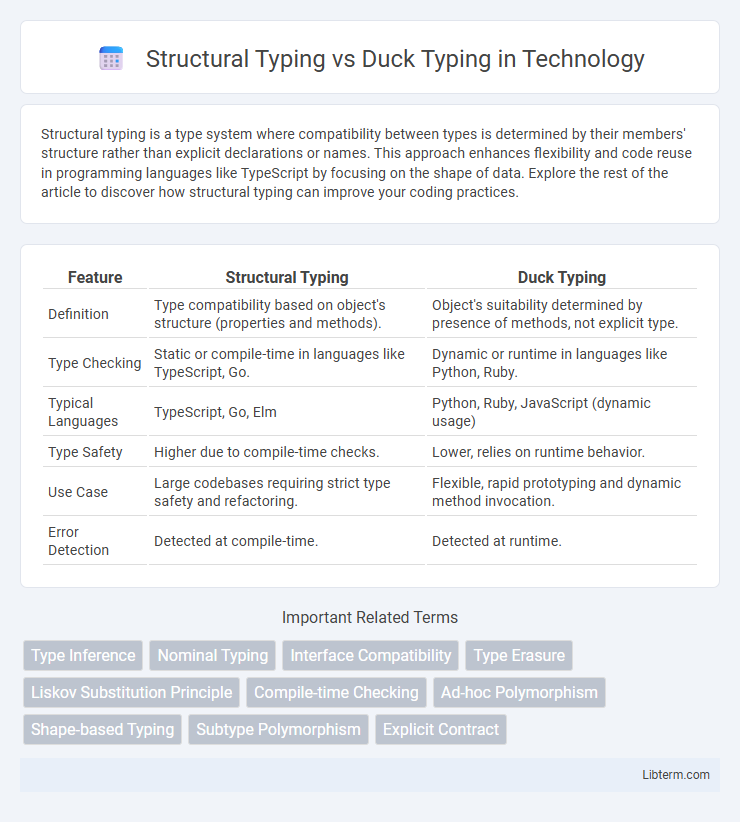Structural typing is a type system where compatibility between types is determined by their members' structure rather than explicit declarations or names. This approach enhances flexibility and code reuse in programming languages like TypeScript by focusing on the shape of data. Explore the rest of the article to discover how structural typing can improve your coding practices.
Table of Comparison
| Feature | Structural Typing | Duck Typing |
|---|---|---|
| Definition | Type compatibility based on object's structure (properties and methods). | Object's suitability determined by presence of methods, not explicit type. |
| Type Checking | Static or compile-time in languages like TypeScript, Go. | Dynamic or runtime in languages like Python, Ruby. |
| Typical Languages | TypeScript, Go, Elm | Python, Ruby, JavaScript (dynamic usage) |
| Type Safety | Higher due to compile-time checks. | Lower, relies on runtime behavior. |
| Use Case | Large codebases requiring strict type safety and refactoring. | Flexible, rapid prototyping and dynamic method invocation. |
| Error Detection | Detected at compile-time. | Detected at runtime. |
Introduction to Type Systems
Structural typing determines type compatibility based on an object's shape and properties, allowing more flexible code reuse without explicit declarations. Duck typing relies on an object's behavior or the presence of specific methods and properties at runtime, emphasizing dynamic type checking. Both approaches offer unique advantages in type systems, influencing how languages enforce type safety and enable polymorphism.
What is Structural Typing?
Structural typing is a type system where compatibility and equivalence of types are determined by their actual structure or shape, rather than explicit declarations or names. It allows objects to be considered of the same type if they have the required properties and methods, enabling flexible and reusable code in languages like TypeScript and Go. This approach contrasts with nominal typing, which relies on explicit type names for compatibility checks.
What is Duck Typing?
Duck typing is a dynamic typing concept in programming where an object's suitability is determined by the presence of certain methods and properties rather than its actual type. It emphasizes behavior over inheritance, allowing objects with similar functionality to be used interchangeably without sharing a common parent class. This approach is common in languages like Python and JavaScript, enabling flexible and extensible code by focusing on what an object can do instead of what it is.
Key Differences Between Structural and Duck Typing
Structural typing determines type compatibility based on an object's actual shape or structure, meaning if an object has all required properties and methods, it is considered of that type, typically used in statically typed languages like TypeScript. Duck typing, common in dynamically typed languages such as Python, relies on an object's behavior or the presence of methods and properties at runtime rather than explicit type declarations. The key difference lies in static versus dynamic type checking: structural typing verifies type conformity at compile time, providing early error detection, while duck typing checks at runtime, offering greater flexibility but potentially more runtime errors.
Advantages of Structural Typing
Structural typing enhances type safety by ensuring compatibility based on an object's actual shape, preventing many runtime errors common in duck typing. This approach enables better static analysis and tooling support, facilitating early detection of bugs during compilation. Structural typing promotes more predictable code behavior and improves maintainability by explicitly defining required properties and methods.
Benefits of Duck Typing
Duck Typing enhances flexibility by allowing objects to be used based on their behavior rather than their explicit type, which enables seamless integration of diverse components in dynamic languages like Python and Ruby. It reduces the need for rigid inheritance hierarchies, promoting more reusable and adaptable code by emphasizing method compatibility over class identity. This approach speeds up development and simplifies testing by focusing on an object's capabilities, improving code maintainability in evolving software systems.
Real-World Examples and Use Cases
Structural typing is prevalent in TypeScript, where type compatibility relies on an object's shape, enabling seamless integration of APIs like React components without explicit type declarations. Duck typing, dominant in Python, stresses behavior over explicit types, useful in dynamic scenarios such as polymorphic functions handling diverse data objects in frameworks like Django. Real-world use cases show structural typing excels in large-scale applications needing strict type safety, while duck typing benefits rapid prototyping and flexible codebases with evolving requirements.
Performance and Safety Considerations
Structural typing enhances safety by ensuring objects conform to expected shapes at compile-time, reducing runtime errors and improving code reliability. Duck typing offers flexibility and faster development but can lead to runtime type errors, potentially impacting performance due to additional checks. Performance-wise, structural typing benefits from early error detection and optimization by compilers, while duck typing relies on dynamic type checks that may introduce overhead during execution.
Language Support for Structural and Duck Typing
Structural typing is primarily supported by statically typed languages such as TypeScript, Go, and Scala, where type compatibility is determined by an entity's shape or structure rather than explicit declarations. Duck typing is a hallmark of dynamically typed languages like Python, Ruby, and JavaScript, where an object's suitability is assessed by the presence of certain methods and properties rather than its actual type. Languages like TypeScript blend both paradigms by providing static type checking with structural typing principles while enabling flexible, dynamic behaviors akin to duck typing.
Choosing the Right Typing Approach
Choosing the right typing approach depends on the development context and project requirements. Structural typing enables type compatibility based on the shape of data, promoting flexibility and safer refactoring in statically typed languages like TypeScript. Duck typing, common in dynamically typed languages such as Python, emphasizes behavior over explicit type definitions, offering rapid prototyping but potentially increasing runtime errors.
Structural Typing Infographic

 libterm.com
libterm.com